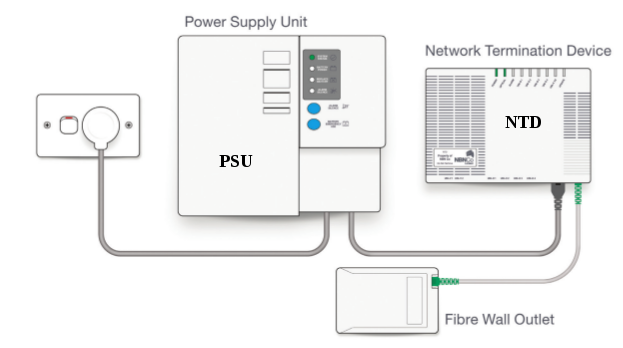When the NBN comes to your place to replace the copper wiring, you'll have the following equipment (or something similar) installed inside your premises (if they're running fibre optic cable up to the outside of your house), as illustrated below.

The Power Supply Unit (PSU) powers the Network Termination Device (NTD), and it can power any basic phones that are plugged directly into the NTD. That's, the older style of corded phones that simply plugged into the old phone wall socket, and didn't have a separate power pack plugged into the mains. Cordless phones, that need a mains power supply into their base station, will not be powered by any of the NBN equipment.
The power supply can have a battery installed, that will power the NTD and basic phones, for several hours if the mains fails. This allows you to make emergency calls, and allows any home alarm systems (that need to make phone calls) to carry on working should your mains power go off. While Telstra has claimed that it can only supply battery power to one phone plugged into the UNI-V1 phone port, my tests have shown this to be a lie (i.e. other ports remain working, as well as the phone port, when the mains power is removed).
The NTD has two (Uni-V) phone sockets for plugging two separate phones into it, and four (Uni-D) ethernet sockets for connecting four different computer equipment directly into it. (NB: Uni-V for voice, Uni-D for data.) All of them are independent from each other, and can be connected to four different internet service providers (despite what some salespeople would have you believe).
Imagine the scenario of installing this equipment into the hallway of a boarding house: There could be a phone going to an office, and a phone in the hallway for the residents. There could be an internet connection going to the office, and three other internet connections going to the resident's rooms. All of these services would be completely independent from each other. They'd all get their own bills, with whatever company they signed on with, with whatever features and services they wanted to order.
Or it could go to an office, with two phone lines, and one or more internet services (an office might want two independent ISPs, so they have back-up if one screws up, or they might need completely isolated internet services between different departments).
On the other hand, if you were having this installed in your private home, chances are that you have one phone and one internet service. But you might have more than one device that connects to the internet (e.g. desktop computer, laptop computer, smart TV, etc.), so you plug a gateway router box into one data port on the NTD, and your gateway provides the connections to everything else. It's a junction box, so to speak. Everything joins to it, and it routes the signals through it where they need to go. Essentially it's just another box that looks pretty much the same as the NTD. And your phone either plugs directly into the NTD, or into the gateway.
If you're unlucky, like me, your phone company connects your phone through the gateway device, instead of directly to the NTD, and this brings about a few telephone problems: Your phone won't work if the power fails, because your gateway doesn't work when the power fails. So you better not need to ring for an ambulance during a power outage. And your phone may work badly if your internet gets rate-limited, particularly if you try to do something on the internet at the same time as use your phone. When the phone is routed through a gateway, your phone signal (the sound) is sent as part of your internet data, and there may not be sufficient capacity to carry the phone data, as well, without disruptions (e.g. I experienced ever-increasing delays for the sound to be transmitted, and eventually the call completely failed). And if the equipment isn't installed where you can easily connect it up to your existing phone cabling, you have to go through the expense of rewiring.
Rate-limiting: Many ISPs will slow down your connection speed if you go over a monthly quota of data. You go down from your usual multi-megabits per second, to a quarter of a megabit per second, on my ISP. Many things simply fail to work under these conditions. Whether this is because the modern internet expects faster speeds, or because the ISP hasn't properly reconfigured the equipment for working at slow speeds, I don't know. But I've come to the conclusion that they do this to convince you to spend more money, rather than put up with a slow service until your quota resets.
The PSU is a whacking great big beige box, about a foot square, and the NTD gets hidden behind another whacking great big beige box, of a similar size, and chances are that they want to install them in an inappropriate, or annoying location. And in our case, the fibre optic cable it just poked through a hole they badly drilled through the brickwork, without any coverplate placed over it.